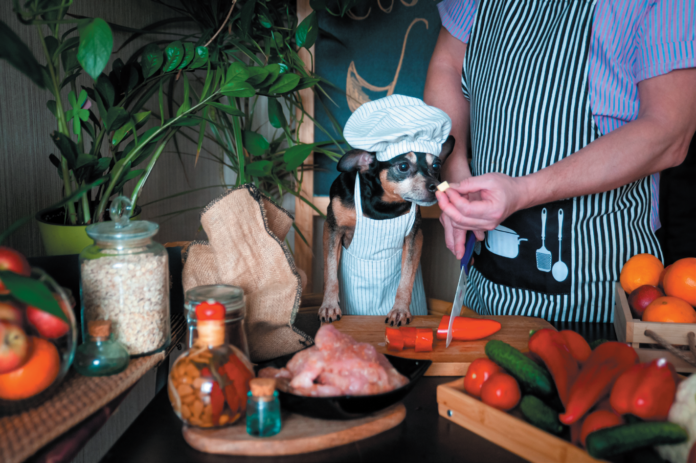“Feeding kibble is akin to feeding your child junk processed food his entire life,” one Your Dog reader wrote in. She’s not alone in her opinion. When the veterinarians at the Tufts Clinical Nutrition Service for pets surveyed dog owners on why they chose to cook their dogs’ meals rather than buy bags of kibble or canned pet food at the store, almost 20 percent of respondents said they felt homemade diets were superior. Almost one in seven said flat out that they had a mistrust of commercial dog foods.
“If folks want to home cook dog food, that is a viable option,” says Deborah Linder, DVM, a board-certified veterinary nutritionist and one of the doctors who conducted the survey, published in the Journal of Small Animal Practice. “For me personally, it’s important to feed a food that has undergone clinical feeding trials. I love testing. I love information. That comes from companies that can feed a diet to many animals and then do large-scale analyses to see how the dogs fare. But cooking for your dog in your own kitchen can be done. In fact, in some cases, it needs to be done. A dog may have a medical condition for which there is not a commercial diet out there that meets their nutritional needs. That, in fact, was the reason a number of the survey respondents chose to cook their dogs’ meals for them. They wanted to take a hands-on approach to manage a disease, and that’s fine. It just has to be done safely.”
Choose a home-cooking teammate
“Cooking your dog’s meals is a lot of responsibility to take on,” Dr. Linder says. “You become your own pet food company. Do you have quality control? Do you have the expertise? There are 30-plus essential nutrients that a dog needs. You want to make sure your pet has all of them — and in the right balance. That’s why, if you’re going to be taking on the role of cook for your dog, you want to make sure you have an expert in your corner to be certain that you’re doing it right.”
That expert is most likely not someone who has devised a recipe you come across on the Internet, or in a book. In fact, research has shown that such recipes are, for the most part, woefully inadequate.
Instead, the expert you want in your corner is a board-certified veterinary nutritionist. There are two ways to engage one.
- Find one at the website of the American College of Veterinary Nutrition (ACVN.org). You can either plug in your location and see if there’s a veterinary nutritionist nearby, or look at the full list of board-certified veterinary nutritionists by clicking on the “ACVN Diplomates” tab. The doctor doesn’t necessarily need to be in your area, as many are doing telehealth.
- Consider a website made by a board-certified veterinary nutritionist to help people create their dogs’ homemade diets. Some of these doctors also create supplements that can be incorporated into the recipe to make sure the diet you feed your dog is complete and balanced. “I include a supplement in almost every recipe to ensure it is fortified with nutrients in specific amounts that I know have been tested to be easily absorbed by dogs,” Dr. Linder says. “That helps increase confidence about meeting — but not overdosing on — all those essential nutrient needs. Our own foods — breads, cereals, and other items — are fortified with vitamins and minerals, too.
“The supplements featured on those sites are also created for dogs rather than for people,” Dr. Linder says. “That’s better for the narrow ranges of safety for nutrients in dogs, who are smaller than we are.”
Working with a veterinary nutritionist does not necessarily come cheap. If you work with one directly instead of going the online route, it will probably cost a few hundred dollars for the initial consult and the time it then takes for the doctor to devise a diet specifically for
your dog. But if it is important to you — or to your dog’s health — it is not unreasonable to consider it money worth spending.
Diet drift
Unfortunately, even those people who work with a veterinary nutritionist to help them create nutritious homemade meals for their dogs often don’t end up feeding those meals. In the Tufts survey, only 13 percent of the respondents adhered strictly to the recipes. Some people changed ingredient amounts by using non-specific weights, for example, using two chicken thighs rather than 9 ounces of chicken weighed on a scale. Some changed meal preparation methods, using raw chicken instead of baked. Others decided on their own to reduce calories without regard for how that would shift nutrient totals and the balance between nutrients. The researchers call it diet drift. A dog parent begins with a nutritionally complete menu for a homemade diet but deviates from the recipe instructions over time.
It becomes particularly concerning when a dog has a medical condition — the reason many people choose a homemade diet for their pet in the first place. With something like kidney disease, heart disease, or pancreatitis, the nutritional profile of a dog’s meals is integral for staving off an untoward medical event and also for slowing the progression of an illness. Mess with the ingredients, even unintentionally, and all your hard work at the grocery store and in your kitchen goes down the drain because the sick dog does not get the dietary benefit he is supposed to.
“If the recipe calls for 90 percent lean beef and you buy 85 percent lean because you couldn’t find 90,” Dr. Linder says, “the diet may now be inappropriate for a pet depending on the disease he has. Or it may be unbalanced. You’ve really got to use precision — consistency of ingredients and weighing things out. Six ounces can’t become 6.5 ounces or 7 ounces. Every change can really alter a recipe.”
A related issue is that what a dog is supposed to eat may change over time. A disease may worsen, necessitating a new balance of vitamins and minerals. It’s for that reason that Dr. Linder says it’s important to stay in touch with the board-certified veterinary nutritionist you choose. The doctor will follow your dog over time and will tweak the recipe to suit your pet’s health profile.






Thank you for all the information you put on this website. I can go back and read it time and time again to give me some comfort and knowledge about how to treat my dog who has diagnosed with liver failure. I really appreciate the work and effort you put into making this available.